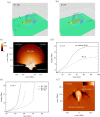The emergence of magnetic flux and its role on the onset of solar dynamic events
- PMID: 31079584
- PMCID: PMC6527958
- DOI: 10.1098/rsta.2018.0387
The emergence of magnetic flux and its role on the onset of solar dynamic events
Abstract
A plethora of solar dynamic events, such as the formation of active regions, the emission of jets and the occurrence of eruptions is often associated with the emergence of magnetic flux from the interior of the Sun to the surface and above. Here, we present a short review on the onset, driving and/or triggering of such events by magnetic flux emergence. We briefly describe some key observational examples, theoretical aspects and numerical simulations, towards revealing the mechanisms that govern solar dynamics and activity related to flux emergence. We show that the combination of important physical processes like shearing and reconnection of magnetic fieldlines in emerging flux regions or at their vicinity can power some of the most dynamic phenomena in the Sun on various temporal and spatial scales. Based on previous and recent observational and numerical studies, we highlight that, in most cases, none of these processes alone can drive and also trigger explosive phenomena releasing considerable amount of energy towards the outer solar atmosphere and space, such as flares, jets and large-scale eruptions (e.g. coronal mass ejections). In addition, one has to take into account the physical properties of the emerging field (e.g. strength, amount of flux, relative orientation to neighbouring and pre-existing magnetic fields, etc.) in order to better understand the exact role of magnetic flux emergence on the onset of solar dynamic events. This article is part of the theme issue 'Solar eruptions and their space weather impact'.
Keywords: eruptions; jets; magnetic fields; sun.
Conflict of interest statement
We declare we have no competing interests.
Figures







References
-
- Parker EN. 1955. The formation of sunspots from the solar toroidal field. Astrophys. J. 121, 491 (10.1086/146010) - DOI
-
- Zwaan C. 1985. The emergence of magnetic flux. Sol. Phys. 100, 397–414. (10.1007/BF00158438) - DOI
-
- Schmieder B, Archontis V, Pariat E. 2014. Magnetic flux emergence along the solar cycle. Space Sci. Rev. 186, 227–250. (10.1007/s11214-014-0088-9) - DOI
-
- Green LM, Török T, Vršnak B, Manchester W, Veronig A. 2018. The origin, early evolution and predictability of solar eruptions. Space Sci. Rev. 214, 46 (10.1007/s11214-017-0462-5) - DOI
LinkOut - more resources
Full Text Sources

